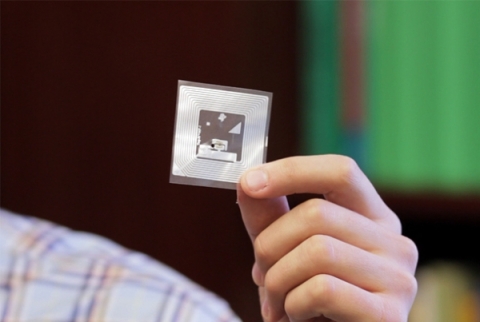Blog Archives
Three amazing technologies that could be part of your new smartphone
That little computer you carry around in your pocket is already your camera, navigation device, instant messaging machine, ride-hailing tool and phone. But it’s very possible that, in the not-so-distant future, what we now refer to as “smartphones“ will actually seem pretty dumb and paper-weighty.
As technology evolves, that mini-computer you are already way too obsessed with is bound to get even more useful. Here are three features that could be in the cell phones of tomorrow.
1. A spectrometer.
What it is: A spectrometer is a tool typically used in physical, chemical and biological research that measures properties of light to analyze an object’s chemical makeup. Until recently, spectrometers were too large to carry around, but that has changed. A company called Consumer Physics introduced a handheld spectrometer named Scio last year, and more recently, MIT announced that scientists at the university have developed a spectrometer small enough to fit inside a smartphone camera.
What it could mean for your smartphone: In a smartphone, a spectrometer could give users an easy and accurate way to detect skin conditions, track a person’s vital signs or identify environmental pollutants. It could also give users a way to find out what’s in their food or medication.
2. Crazy accurate GPS.
What it is: Geolocation technology is already widely used in smartphones. That’s how and why you can follow driving directions with Google maps, get picked up by an Uber, or ask your smartphone to locate the closest Starbucks. But geolocation software developed by engineers at the University of Texas at Austin makes it possible to identify a position accurately to within a centimeter using the inexpensive antenna sensors that are in smartphones. Centimeter-accuracy GPS systems already in existence depend on large and expensive hardware.
What it could mean for your smartphone: Synced with the camera in your smartphone, this down-to-the-centimeter GPS would make it possible to instantly map your surroundings in 3-D, increasing the subtle sophistication of virtual reality technology. Also, centimeter-specific geolocation would allow cars to sense and avoid each other in more nuanced situations.
3. Gas sensors.
What it is: New inexpensive wireless sensors developed by chemists at MIT detect gaseous ammonia, hydrogen peroxide, cyclohexanone and other dangerous gases, and can be read by a smartphone. The sensors are also noteworthy because they don’t need to be plugged in. The technology necessary to read these tags already exists in most smartphones.
What it could mean for your smartphone: The gas-sensor-tag and smartphone reading combo would make it super easy to measure explosive chemicals or hazardous environmental pollutants. The chemical readings from smartphones could be combined with geolocation data to track and map hazardous regions.
Also, a sensor could be fixed to food so that anyone with a smartphone could assess the freshness of food. The sensors could measure chemicals released by rotten or spoiled food.
Source: entrepreneur
WWDC 2015: iOS 9, HomeKit, Apple Pay and more announcements to expect
Analysts, investors and all eager Apple fans are gearing up for the Worldwide Developers Conference, or WWDC, from June 8-12 in San Francisco. The company plans to reveal many interesting products, be it hardware or software. Apple has now confirmed that the keynote will be streamed live from Moscone Center. According to the invitation, the event is about to become ‘The epicenter of change.’ Here’s a closer look at what we can expect at WWDC 2015.
1. iOS 9
There’s a lot being said about iOS 9 and how it might be the clear-cut star of the event. As per rumours, Apple’s biggest addition will include taking on Google Now with a new iOS initiative internally called Proactive. According to 9To5Mac, Proactive will leverage existing features such as Siri, Contacts, Calendar, Passbook, and third-party apps ‘to create a viable competitor to Google Now’. The company also has plans to introduce a new smart home app for iOS 9 called ‘Home’. The new app will allow a user to set up new smart home products such as Wi-Fi garage door openers, smart thermostats akin to Nest’s Learning Thermostat, and wireless door locks with iPhones and iPads.
Additional features included may revolve around a new security system called Rootless, that is called a huge kernel-level feature for OS X as well as iOS. It is aimed at preventing malware, improving safety of extensions and will prevent administrative-level users from accessing certain data on the devices. It is also said to be huge blow to the jailbreak community.
For Apple, iOS 9 is all about change. The company has penned down a new strategy as well, as it expects to widen the time/life span of support for its older devices including the iPhone 4S. Needless to say, this will help the company maintain a foothold in emerging markets where people don’t really replace a high-end device every time its new variant arrives. All in all, Apple isn’t worrying about designing a flashy new OS, but will rather focus heavily on improving stability and optimisation for their yet to release iOS 9.
2. Apple Watch
It’s been over a month since we witnessed Apple’s smartwatch, but it seems like the spark for the device has already dialed down. As of now, Apple has only only released its first OS update which include a few bug fixes and new language support. But apart from this, developers see the watch’s main benefits as saving time or the labour of frequently taking out a phone. In conversation with 9to5mac, Apple’s senior vice president of operations Jeff Williams revealed that a software development kit designed to create Watch-native apps would be released during WWDC.
This implies that we can expect third party apps which will not find the need to be paired to the iPhone at all times, but will able to run independently on the Watch itself. Rumour has it that the company also has plans to replace its favoured font Helvetica Neue across iOS 7 upwards with a custom-designed San Francisco typeface, according to this report.
3. Apple’s new streaming music service
Apple’s upcoming music streaming service, which is based on the recently acquired Beats, will reportedly be dubbed Apple Music. What is rather interesting is that this new service will be resemble Apple’s now-defunct Ping social networking system, which was officially closed on September 30, 2012 and replaced with Facebook and Twitter integration in iTunes. Apple is most likely to unveil the new streaming music service at WWDC, according to the Wall Street Journal and is said to cost $10 per month and provide unlimited listening as well.
Re-branding the acquired Beats Music service, the new service could be built into iTunes and the iOS Music app. According to the report, Apple also plans to augment its free, ad-supported Internet radio service with channels programmed and hosted by human DJs. The service is said to debut at WWDC and might launch a few weeks later.
4. Apple’s new television service
Speculation is mounting that Apple’s take of the future of TV is going to be focused on delivering a new type of service, rather than a new piece of hardware. Wall Street Journal had reported that the new service would have about 25 channels, anchored by broadcasters such as ABC, CBS and Fox and would be available on Apple devices such as the Apple TV. The recent announcement of HBO Now also supports rumors that Apple is interested in streaming TV content. The service’s retail price is expected to be $15 a month.
5. Apple Pay
Apple Pay, which was a hit with over a million activations in 72 hours, may have a few announcements lined up at WWDC. Apple is expected to introduce a new rewards program for the payments service. The company could finally announce its expansion plan for Apple Pay to more countries such as India, Europe, Middle East and Africa, as rumoured last year. Details on Apple pay announcements for WWDC and scarce.
6. HomeKit
Apple may finally officially launch its home automation platform, HomeKit and WWDC. HomeKit is a set of tools in Apple’s iOS 8 software designed to work with smart home devices. The company announced the home automation platform at its conference for developers last year, but devices compatible with the software have yet to appear in stores.
According to a report, accessories for Apple’s HomeKit will hit stores this month. The HomeKit app called Home may also be introduced as part of iOS 9. Apple spokeswoman Trudy Muller said in a statement last month that, “HomeKit has been available for just a few months and we already have dozens of partners who have committed to bringing HomeKit accessories to market and we’re looking forward to the first ones coming next month.”
7. OS X 10.11
The potential name for Apple’s next OS X operating system codenamed OS X 10.11 Gala is most likely to have a preview at WWDC. The OS X 10.11 will most likely focus heavily on bug fixes, optimization improvements, and security enhancements, much like the iOS 9. According to rumours, Apple may convert many IMAP-based applications like Notes, Reminders, and Calendar to its own iCloud Drive system, improving communication in these apps between devices and increasing security.
A trusted Wi-Fi feature will allow Macs and iOS devices to connect to authorized wireless routers without additional security measures. It would add more heavily encrypted wireless connection for non-trusted routers.
Source: FirstPost
Microsoft plans to de-clutter your Outlook inbox
 This June, Microsoft will turn on Clutter by default for Outlook users. The Office 365 email inbox management feature will clean up your inbox so that it displays important messages.
This June, Microsoft will turn on Clutter by default for Outlook users. The Office 365 email inbox management feature will clean up your inbox so that it displays important messages.
“It uses machine learning to de-clutter your inbox by moving lower priority messages out of your way and into a new Clutter folder,” Microsoft said of the feature in a statement. “Ultimately, Clutter removes distractions so you can focus on what matters most.”
Clutter is similar to rival Google’s Priority Inbox for Gmail.
Learning using Office Graph
Clutter uses the Office Graph to learn which messages are important to you, and you can also train Clutter to identify messages that are of low priority.
Over one million messages are automatically moved each day into the Clutter folder today, and Microsoft claims this helps users save on average 82 minutes each month from having to sort through non-important emails.
In Outlook, you can flag messages as clutter or move them to the Clutter folder, and Clutter will learn those actions, so that similar messages will skip the inbox and move straight into that folder in the future.
“The information Clutter learns from each user’s actions are only applied to that user’s experience and are not shared with anyone else,” Microsoft said of the personalization.
This is similar to Google’s approach with Gmail’s Priority Inbox. Gmail’s tabs automatically identify content as priority – based on the people in the conversation and your prior communications with them – as well as social, promotions and updates. Google automatically identifies if the message is an update to a forum and places it in the updates folder, or if it’s a message from Facebook and places it into the social folder. The promotions folder includes any email you get from advertisers.
Messages that shouldn’t belong in Clutter can be moved out to the main inbox again.
Enabling Clutter
Clutter will be automatically enabled by default for new and existing Outlook accounts starting in June. For business users, Microsoft is also enabling controls to let administrators manage Clutter with PowerShell cmdlets.
If a message is moved into the Clutter folder automatically for the first time, Microsoft will send the user an alert to notify them. A maximum of one alert is sent out each day, and a weekly summary provides users with a status report on what messages are being moved to Clutter.
Users who prefer the old experience can opt out from having to use Clutter.
TOI
Dot-com to .pizza: Welcome to the Web domain rush
 The Internet’s long-restricted virtual real estate market is open for business.
The Internet’s long-restricted virtual real estate market is open for business.
Hundreds of new so-called top-level domains (TLDs) like .photography, .expert and .pizza are available now that the Internet Corporation for Assigned Names and Numbers (ICANN), which oversees the domain name system, has expanded access to suffixes.
A handful of companies that prepared years ago to take advantage of this land grab are in a position to profit handsomely for years to come.
The new opening will also be a boost for brands looking to strengthen their online presence, but have been thwarted by domain-name squatters charging top dollar for the last remains of the dot-com universe.
One business, the sports training group Fast Twitch, jumped on the trend early. The company’s three elite training facilities in South Florida attract major league pitchers, pro boxers and all-star football players. But try finding the company online at fasttwitch.com and you’ll land on a generic website telling you the domain is for sale.
The dot-com game is too pricy for Fast Twitch Chief Development Officer James Meder. As a small business operator on a tight budget, he refuses to plop down $20,000 for a domain.
Fortunately for Meder, the new level of TDL suffixes means he no longer has to. Early this year, for an annual fee of about $40, Meder launched his website using the brand new address fasttwitch.training.
“Being a training company, this is a catchy, quick way to brand ourselves,” said Meder, whose Miami-based company operates in partnership with sports apparel and accessories provider Under Armour. “It’s another piece of trying to do something unique.”
Other currently live pages include beingamom.life, a website for mothers, and any.business, a small business content site. Donuts, a major buyer of new TLDs, calls it the “Not Com Revolution,” because the past 30 years on the Web have been a dot-com circus.
The original .com suffix, short for commercial, is the default method for establishing a corporate address, while .org has been the go-to extension for nonprofits and .edu for colleges and universities. According to Verisign, which manages .com websites, 115.6 million of the 288 million domains registered across the globe end in .com. (Tweet This)
“It’s a very saturated name space,” said Bhavin Turakhia, founder and CEO of Radix, the owner of rights to new suffixes including .website, .space and .site. “You really can’t find any good, short, easy-to-remember names.”
To get around the shortage, U.S. start-ups have turned to using country codes like .ly (Libya), .me (Montenegro) and .tv (Tuvalu) in building their online presence.
In June 2011, ICANN announced the plan to increase the number of TLDs to let organizations “market their brand, products, community or cause in new and innovative ways.” A bidding process took place in early 2012, and by January 2014, new addresses started coming online.
More than 600 new TLDs have been purchased, and about 350 of those are available today, according to nTLDStats. Some 5.6 million new addresses are live, with .xyz, .science and .club ranking as the most popular English suffixes.
Top English TLDs
Suffix # of domains Market share
.xyz 931,353 16.6%
.science 294,933 5.3%
.club 229,797 4.1%
.berlin 155,401 2.8%
.wang 145,726 2.6%
.link 113,910 2.0%
.party 108,949 1.9%
The domain boom is breathing life into a historically quiet corner of the Internet.
It’s certainly not a corner that Meder knew or cared much about until 2013, when he stumbled upon a Twitter conversation about a company called 1and1.
The tweets caught his eye because Fast Twitch had been struggling for years with various dot-com iterations, like FT-PT.com and AreYouFastTwitch.com. Meder did some research on 1and1 and found that a wealth of new addresses would soon be available for purchase.
He settled on fasttwitch.training as the official site, purchased the address from 1and1, and migrated over from the dot-com world at the beginning of this year.
While Meder is excited about the URL’s potential, he’s encountered some frustrations in being an early adopter. One is the difficulty in using his email address when registering with online businesses, because many websites aren’t yet recognizing the new domain extensions.
Consumers, like machines, have to adapt to an all new Internet. Millions of new sites are certain to create some level of chaos and abuse. And with the mass transition to mobile apps, it’s not even clear how important URLs will be in the future.
But the publicity opportunities for Fast Twitch more than outweigh the risks, according to Meder.
“It’s a conversation piece,” he said. “It gives us the chance to talk about it.”
Stories like Meder’s give 1and1 punchy anecdotes for its own marketing efforts. The German company is among thousands of domain name registrars, or entities that act as Web address retailers. They sit between the registries like Verisign, Donuts and Radix and domain buyers like Fast Twitch.
“It puts an end to the scarcity of dot-com names.”
-Thomas Keller, director of domain services at 1and1
GoDaddy is the biggest registrar in the market, with 59 million domains, compared with 19 million for 1and1. GoDaddy sold shares to the public in April and is valued at $4.1 billion.
Recenty released TLDs already account for about 15 percent of 1and1’s new business, according to Thomas Keller, the company’s head of domains. It’s lucrative, too, with the new TLDs selling for about $40 a year on average, more than double the typical .com addresses.
More importantly, companies finally have options and aren’t forced to pay ridiculous prices to domain hoarders. According to Keller, 90 percent of searches on the 1and1 site for .com names show that the address is not available.
“It puts an end to the scarcity of the dot-com names,” he said. “It will have a huge influence over time.”
For .training alone, there are about 16,000 registered names. Every time 1and1, GoDaddy or another registrar sells an address with that extension, Donuts gets a substantial share of the revenue, because the Bellevue, Washington-based company owns its exclusive rights.
Donuts is an Internet registry, a designation that gives it the unique ability to buy TLDs after a thorough vetting by ICANN. In that market, Donuts owns the most unique suffixes and competes with companies including global Internet powerhouses Google and Amazon.com along with Radix, Afilias and Rightside.
Donuts was founded in 2010 by a four-person team betting that ICANN would soon open up the TLD universe. Over the past five years, the company has raised $150 million from venture investors and private equity funds, mostly to load up on suffixes.
A screen shows a rolling feed of new ‘Generic Top-Level Domain Names (gTLDs) which have been applied for during a press conference hosted by ICANN in central London, on June 13, 2012.
A screen shows a rolling feed of new ‘Generic Top-Level Domain Names (gTLDs) which have been applied for during a press conference hosted by ICANN in central London, on June 13, 2012.

A screen shows a rolling feed of new ‘Generic Top-Level Domain Names (gTLDs) which have been applied for during a press conference hosted by ICANN in central London, on June 13, 2012.
When ICANN initiated bidding in 2012, Donuts went on a spending spree, applying for more than 300 names. A nonrefundable application fee of $185,000 was required for every TLD the company wanted to pursue. For Donuts, that added up to $58 million.
“We went through an amazing amount of data in terms of how words are used commercially,” said Richard Tindal, Donuts’ co-founder and chief operating officer. “We picked the 300 we viewed as the most commercially marketable, through a combination of art and science.”
If more than one registry applied for a given suffix, the process went to an auction and the winner was determined by the highest bidder. Google spent a hefty $25 million for control of .app, while .tech, owned by Radix, was purchased for $6.8 million, according to ICANN.
Donuts has about 165 suffixes on the market now and is in the process of rolling out 15 more. The company expects to end up with about 200, in many cases spending several million dollars for a single TLD.
If its wagers pay off, millions of sites will be paying Donuts $20, $50, $100 a year and more.
For .training, Donuts paid only the $185,000 application fee, because no other bidders emerged. The name has already been profitable three times over, Tindal said.
“It’s a really great business,” Tindal said. “The more your product gets seen the more people like it.”
While most of the .training names will retail for about $30 a year, Tindal is quick to point out that fitness is just one way to use the suffix. There’s a whole other group of sites focused on education. AWS.training, a site for taking classes on Amazon Web Services, is already up and running.
Jeff Davidoff, former chief marketing officer of Orbitz and Bono’s ONE Campaign, is tasked with turning the Not Com Revolution into a mainstream business. As CMO of Donuts, he’s meeting with prospective customers at conferences like South by Southwest and helping users of new TLDs tell their stories.
He’s convinced the market is about to tip.
“This isn’t hypothetical anymore,” Davidoff said. “So much of the history was four smart guys making bets on what the future could be. It’s not a question of whether this will stick, it’s just a question of how quickly it gets to be the new normal.”
CNBC
IBM, Deloitte bring big data to risk management
 IBM and Deloitte are betting that computers can understand reams of financial regulatory guidelines more thoroughly, and speedily, than humans.
IBM and Deloitte are betting that computers can understand reams of financial regulatory guidelines more thoroughly, and speedily, than humans.
The two companies have developed a system that can parse complex government regulations related to financial matters, and compare them to a company’s own plans for meeting those requirements.
The work is part of an ongoing partnership between the two companies to help financial firms and other organizations use advanced data analysis techniques to improve their practices around risk management.
Risk management is the discipline of understanding, and mitigating against, what could go wrong in an organization’s plans. It requires an assessment of conditions that could hamper an organization’s plans, and how much monetary damage such events could cost a company.
Businesses have been under increased pressure in the past few years, from governments, shareholders and the public, to provide more information about how they assess and report potential risks. Many enterprise software companies, such as SAP, Oracle and SAS, have offered risk management packages to help.
IBM and Deloitte are saying that recent advances in data analysis and cognitive computing can help an organization better understand, and report on, risk factors.
The two companies have created a regulatory compliance and control service that harnesses some of these new technologies. The service draws on Deloitte’s considerable experience in regulatory intelligence, and uses IBM’s cloud capabilities and big data-style analysis techniques.
For instance, the service will use IBM’s Watson-branded cognitive computing services to parse written regulations paragraph by paragraph, allowing organizations to see if their own frameworks are meeting the mandates described in the regulatory language.
This analysis could help cut costs of meeting new regulatory guidelines, such as the U.S. Dodd-Frank Wall Street Reform and Consumer Protection Act, passed in 2010 to provide more transparency into U.S. financial services. According to IBM, the IT budgets of financial services are increasingly being allocated to meet these detailed guidelines.
The two companies are also exploring ways that new big data-style analysis can help organizations better anticipate risk factors, by combining Deloitte’s financial expertise with IBM’s predictive analysis technologies.
Today, much unstructured data — or data that does not reside in a traditional database — tends to be excluded by risk assessments. Corporate e-mail, social networks, or server logs could be aggregated and analyzed in real-time to offer a prediction of what events could happen in the future, the companies say.
InfoWorld


















